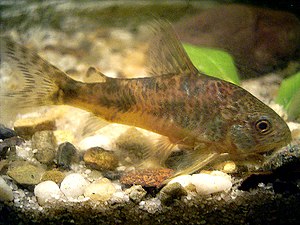Marbled armored catfish
| Marbled armored catfish | ||||||||||||
|---|---|---|---|---|---|---|---|---|---|---|---|---|

Marbled armored catfish ( Corydoras paleatus ) |
||||||||||||
| Systematics | ||||||||||||
|
||||||||||||
| Scientific name | ||||||||||||
| Corydoras paleatus | ||||||||||||
| ( Jenyns , 1842) |
The marbled armored catfish ( Corydoras paleatus ) ( Latin : palea = chaff , dotted ) is a freshwater ornamental fish of the genus Corydoras . It can reach a length of up to about 7 cm and live for 10 to 13 years.
features
Like all armored catfish, the marbled armored catfish is an intestinal breather , which means it has to take a breath from the surface of the water from time to time. In captivity, it should therefore not be kept in a tank with a closed floating plant cover.
- Fin formula : dorsal 1 / 7–8, anal 1/6
ecology
Occurrence
The marbled armored catfish occurs in the basins of the lower Río Paraná of the Río Uruguay and the Río de la Plata in Argentina and Uruguay, as well as in rivers of the Brazilian state Rio Grande do Sul .
nutrition
The marbled armored catfish is omnivorous and feeds by looking for algae, detritus , small animals and parts of plants on and near the ground .
Aquaristics
The animals are schooling fish and should be kept in groups of at least six to seven animals if they are kept in an aquarium, but more animals should be kept in larger aquariums (e.g. 126 l should be at least 10-12). The marbled armored catfish is very peaceful and can easily be socialized with smaller fish or shrimp. A soft, not sharp-edged substrate is important (sand is ideal), as otherwise the animals can injure their barbels. It can be kept in tanks from 54 l (60 cm × 30 cm × 30 cm standard aquarium). The water temperature should be between 20 and 25 ° C. The fish are extremely lively and roam the ground in groups in search of something to eat. They dig in the upper layers. Activity phases are replaced by shared rest phases, with the animals then remaining motionless on the ground or on surfaces for a while. Corydoras paleatus feels at home in a well-structured tank with many hiding spots and a fine substrate such as sand or gravel. The armored catfish usually do not prefer too strong light, but rather dim light. A strong population of aquatic plants can help divide the aquarium into brighter and less lit areas. Roots and caves can also offer retreats. The animals are able to create sounds by rubbing their pectoral fin through a groove on the shoulder girdle, which helps them communicate with one another during mating and flight behavior.
breed
It is a very easy to breed species. Readiness for spawning is initiated by simulating a rainy season (strong, abrupt partial water changes with temperature fluctuations). For successful breeding you should aim for an excess of males (e.g. one female and two males are enough to form a stock), otherwise significantly fewer eggs will be fertilized. The unfertilized eggs easily become fungal and the fungal growth can then spread to fertilized eggs. A female lays around 150 transparent white eggs one after the other, which are glued to large leaves, stones or simply to the panes of the aquarium. The females are characterized by their fullness and size, compared to the smaller, slimmer males. The eggs should be separated from the adults after a short time. The eggs take about 3 to 5 days to hatch. The larvae are very small and partly transparent. Two to three days after hatching, when the yolk sac has been used up, the larvae can be fed with Artemia nauplii. The finest flake feed made from algae and compound feed can be given later. The fish are extremely fertile. Sexual maturity begins at a height of five centimeters. The males show no territorial behavior, nor are there any fights among themselves for females ready to spawn.
Lining
The following food is also suitable in the aquarium: Live food ( Artemia , mosquito larvae , Grindal worms ), frozen food ( Cyclops ) and dry food (tablets, food flakes). The marbled armored catfish is always looking for something to eat on the ground and rummaging through it with its barbels .
literature
- Hans-Georg Evers : Armored catfish: Aspidoras, Brochis, Corydoras. Ulmer Verlag, Stuttgart 1994, ISBN 3-8001-7286-0 .
- Günther Sterba : The world's freshwater fish. Weltbild Verlag, Augsburg 1995, ISBN 3-89350-991-7 .
Individual evidence
- ↑ Günther Sterba: Freshwater fish of the world. Weltbild Verlag, Augsburg 1995, ISBN 3-89350-991-7 .
- ↑ LFC Tencatt, d MR. Britto, CS Pavanelli: Revisionary study of the armored catfish Corydoras paleatus (Jenyns, 1842) (Siluriformes: Callichthyidae) over 180 years after its discovery by Darwin, with description of a new species. In: Neotropical Ichthyology. 14 (1), 2016, e150089 ( online ).
- ↑ a b Corydoras paleatus on Interaquaristik
- ↑ a b c d e f g Fish knowledge Corydoras paleatus
- ↑ Inge Pruzsinszky and Friedrich Ladich: Sound production and reproductive behavior of the armored catfish Corydoras paleatus (Callichthyidae) , Environmental Biology of Fishes. Volume 53, pages 183-191. 1998.
- ^ Ingrid Kaatz: Acoustic Behavior and Reproduction in Five Species of Corydoras Catfishes (Family Callichthydae) . Biological Bulletin. Pages 278-280. 1999
Web links
- Marbled armored catfish on Fishbase.org (English)
- 1. Breeding report about the marbled armored catfish at www.welse.net
- 2. Breeding report about the marbled armored catfish at www.welse.net
- Article about the marbled armored catfish in coryforum.de
- Marbled armored catfish at www.familie-hauffe.de
- Marbled armored catfish at Aqua4You
- Marbled armored catfish at PlanetCatfish


